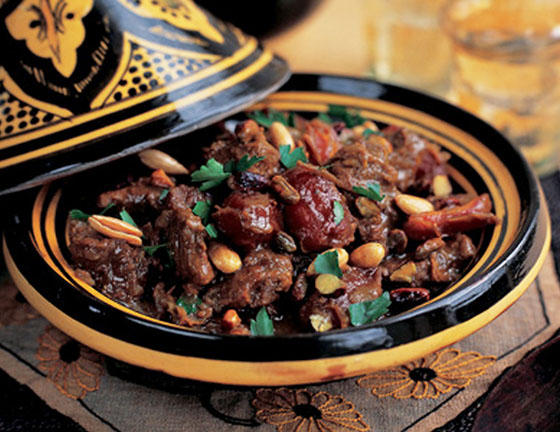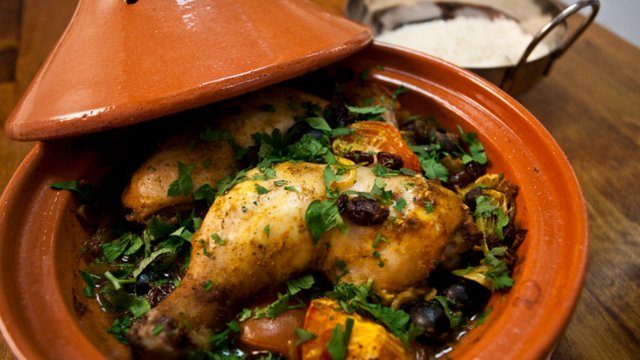
Tajine or tagine is a type of dish found in the North African cuisines of Morocco, which is named after the special pot in which it is cooked. The traditional tajine pot is formed entirely of a heavy clay which is sometimes painted or glazed. It consists of two parts; a base unit which is flat and circular with low sides, and a large cone or dome-shaped cover that rests inside the base during cooking. The cover is designed to promote the return of all condensation to the bottom. With the cover removed, the base can be taken to the table for serving.
Most tagines involve slow simmering of less-expensive meats. For example, the ideal cuts of lamb are the neck, shoulder or shank cooked until it is falling off the bone. Very few Moroccan tajines require initial browning; if there is to be browning it is invariably done after the lamb has been simmered and the flesh has become butter-tender and very moist. In order to accomplish this, the cooking liquid must contain some fat, which may be skimmed off later.
Moroccan tajines often combine lamb or chicken with a medley of ingredients or seasonings: olives, quinces, apples, pears, apricots, raisins, prunes, dates, nuts, with fresh or preserved lemons, with or without honey, with or without a complexity of spices. Traditional spices that are used to flavour tajines include ground cinnamon, saffron, ginger, turmeric, cumin, paprika, pepper, as well as the famous spice blend Ras el hanout. Some famous tajine dishes are mqualli or emshmel (both are pairings of chicken, olives and citrus fruits, though preparation methods differ), kefta (meatballs in an egg and tomato sauce), and mrouzia (lamb, raisins and almonds).

Other ingredients for a tajine include any product that braises well: fish, quail, pigeon, beef, root vegetables, legumes, even amber and aga wood. Modern recipes in the West include pot roasts, ossobuco, lamb shanks and turkey legs. Seasonings can be traditional Moroccan spices, French, Italian or suited to the dish.
Morocco, perhaps feeling pressure to catch up with Europe, is beginning to use the efficient pressure cooker to make tajines. Recently, European manufacturers have created tajines with heavy cast iron bottoms that can be fired on a stovetop at high heat. This permits browning meat and vegetables before cooking. While the similar Dutch oven and Sac spell (sach) (a cast iron pot with a tight cover) braises most efficiently in the oven, the tajine braises best on the stovetop.
Tajine makers, who want to remain loyal to the original cooking methods but save time, can still cook with saucepans and casseroles, but place them over gas versus a slow fire. Regardless of how you make tajine, you should make it with love and care as this will assure a delicious result. Also, keep in mind that it is difficult to make tajines for large groups because they don’t contain much more than sauce. As a result, a tajine is better prepared for your family or an intimate gathering of friends.
Tajines are a delicious meal if you enjoy exotic ingredients like lamb or chicken marinated in olive oil and garlic. (If you are vegetarian, you can request your tajine to be made without meat during your Moroccan travels). Meats are always first sautéed and then embellished with combinations of marinades including saffron, cumin, crushed red pepper, fresh coriander, parsley, chickpeas, and almonds. To be playful with the dishes, Moroccans sometimes add prunes, ginger, or hard boiled eggs. The standard dish will always include chicken, olives and salted lemons.
Some tricks to get your tajine like those of Moroccan mothers include using cooking butter (you can substitute for olive oil) and large quantities of chopped onions. Warm the onions until they reach their softest state; this will help the tajine sauce taste creamier. Adding a touch of honey is another secret.
Some differences in how tajines vary between regions include details of what spices, fats, and seasonal produce are used. Regardless of where your ingredients come from, one similarity throughout Morocco is that upon preparation, the tajine is commonly ate with couscous or thick wedges of freshly made hot bread used to scoop up the meat and vegetables.
The most famous dish food in Morocco is Tajine , I am a fan of the Moroccan Tajine😋😋😋
Downvoting a post can decrease pending rewards and make it less visible. Common reasons:
Submit
Hi! I am a robot. I just upvoted you! I found similar content that readers might be interested in:
http://www.travel-exploration.com/subpage.cfm/Tajine
Downvoting a post can decrease pending rewards and make it less visible. Common reasons:
Submit